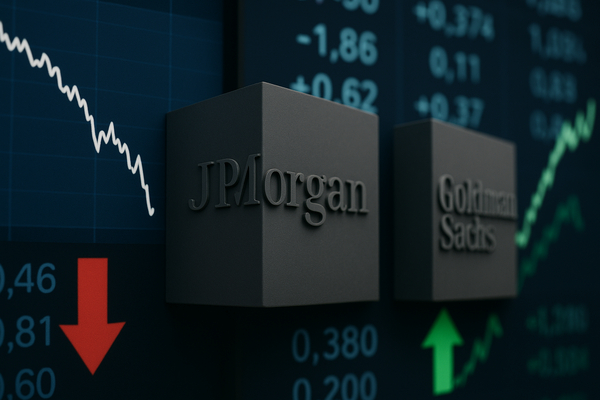
AIG (NYSE:AIG) faces a tangled week of legal exposure and dividend chatter that matters now because headline litigation and bankruptcy linkages are reshaping short-term risk pricing even as long-term underwriting trends remain intact. In the short run, potential claims tied to the First Brands bankruptcy are pressuring insurers and bank counterparties. Over the long run, steady premium growth and capital management still matter. Globally, U.S. insurers and European reinsurers may see higher near-term volatility. Locally, U.S. regional banks and asset managers must price counterparty credit risks more carefully. Compared with past credit scares, the move is swift but narrower so far.
Market Pulse Check
Investor flows turned defensive after a fresh tariff scare and a spate of bankruptcy-related headlines. The fear gauge spiked and trading volumes climbed as market sellers targeted names with direct exposures to trade routes and illiquid credit. At the same time, crypto-related flows and Bitcoin ETF interest kept a handful of tech and asset-manager stocks buoyant.
JPMorgan (NYSE:JPM) and Goldman Sachs (NYSE:GS) set the tone before earnings week by tightening bid-ask spreads and leaning into fees from debt and equity issuance. By contrast, Bank of America (NYSE:BAC) and several regionals lagged, reflecting sensitivity to trade-disruption scenarios. BlackRock (NYSE:BLK) and Coinbase (NASDAQ:COIN) illustrate the split: some asset managers are seeing inflows into crypto products even as traditional lenders retrench.
Analyst Convictions — Upgrades, Downgrades and the Valuation Debate
Analysts remain active. Some firms raised price targets or maintained overweight calls where fundamentals look resilient. Others trimmed expectations after the bankruptcy fallout raised counterparty risk.
- Goldman Sachs (NYSE:GS) teams continue to roll out fixed-income offerings and adjust risk frameworks. That activity supports fee expectations heading into earnings.
- Kinsale Capital (NASDAQ:KNSL) has seen fresh analyst optimism tied to underwriting discipline and growth targets, highlighting why high-conviction calls persist for niche insurers.
Valuation gaps widened. Stocks with steady cash generation and visible fee franchises earned buy-side conviction. High-volatility names without clear cash-flow visibility drew cautious ratings. The divergence underlines how valuation and sentiment are decoupling in several pockets.
Risk Events vs. Expansion — Bankruptcy, Legal Exposure and New Markets
Risk events drove the headlines. Jefferies (NYSE:JEF) and UBS (NYSE:UBS) are wrestling with exposures and redemptions tied to distressed suppliers and private-credit positions. Insurers such as AIG (NYSE:AIG) were named in chatter around potential claims linked to the First Brands bankruptcy, which has immediate implications for reserve setting and claims assumptions.
Meanwhile, growth initiatives pressed ahead. Coinbase (NASDAQ:COIN) applied for a banking-type charter and BlackRock (NYSE:BLK) saw fresh ETF-related flows. Those moves show expansion stories are alive even during episodic stress.
- Short-term: legal filings and portfolio redemptions can sap liquidity and force mark-to-market losses.
- Long-term: access to new products, like tokenized payment rails or ETF lines, may help revenue diversification.
Leadership and Fundamentals — Management Moves and the Real Business Backdrop
Leadership changes are sharpening investor focus on execution. Several firms updated management or expanded senior teams, and those moves are getting outsized attention because governance now interacts with operational risk more visibly than in calmer markets.
AIG (NYSE:AIG) remains front-and-center on governance and capital-allocation debates as legal overhang meets dividend discussion. That combination amplifies short-term sensitivity even when underwriting fundamentals remain stable. At the same time, big franchises with diversified fee businesses — like JPMorgan (NYSE:JPM) and Goldman Sachs (NYSE:GS) — are leaning on scale and balance-sheet flexibility to absorb shocks.
Investor Sentiment
Institutional and retail reactions diverged sharply. Institutions stepped back from illiquid private-credit pools and moved into cash and high-quality liquid assets. Retail traders piled into volatility and crypto-related themes, fueling headline moves in a handful of names.
ETF flow signals show a bifurcated market. Large managers are reallocating across product types while retail-driven inflows exaggerate short-term momentum in selected stocks. The result: valuation disconnects across sectors. Some companies post strong fundamentals but trade weakly because of perceived litigation or counterparty links. Others enjoy high analyst conviction while facing operational headlines that the market is still discounting.
Investor Signals Ahead
Contrasting storylines — analyst upgrades versus downgrades, litigation versus expansion, and leadership changes versus stable fundamentals — are creating a patchwork of winners and losers. In the coming month, expect relative performance to hinge on who can demonstrate capital resilience, clear claims visibility, and measurable fee growth. For now, the market is rewarding depth of franchise and punished headline risk. Investors will watch earnings, legal filings, and fund-flow data to reprice exposures and reevaluate sector leadership.












